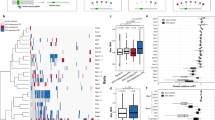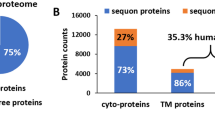Abstract
Src homology 3 (SH3) domains bind specific proline-rich peptide motifs. To identify interactions involved in peptide recognition, we have mutated residues on the putative binding surface of an SH3 domain from the Caenorhabditis elegans protein Sem-5. Among the most critical positions are three adjacent aromatic residues, which appear to participate in highly stereospecific packing interactions with the ligand. The co-planar arrangement of two of these residues closely matches the periodicity of a poly-proline II (PPII) helix. Thus, a model for recognition has the peptide adopting a PPII helix, with the pyrrolidine rings on one helical face interlocking with the aromatic SH3 residues.
This is a preview of subscription content, access via your institution
Access options
Subscribe to this journal
Receive 12 print issues and online access
$189.00 per year
only $15.75 per issue
Buy this article
- Purchase on Springer Link
- Instant access to full article PDF
Prices may be subject to local taxes which are calculated during checkout
Similar content being viewed by others
References
Clark, S.G., Stern, M.J. & Horvitz, H.R. C. elegans cell-signalling gene sem5 encodes a protein with SH2 and SH3 domains. Nature 356, 340–344 (1992).
Simon, M.A., Dodson, G.S. & Rubin, G.M. An SH3-SH2-SH3 protein is required for p21ras1 activation and binds to Sevenless and Sos proteins in vitro. Cell 73, 169–177 (1993).
Olivier, J.P. et al. A Drosophila SH2-SH3 adaptor protein implicated in coupling the sevenless tyrosine kinase to an activator of Ras guanine nucleotide exchange, Sos. Cell 73, 179–191 (1993).
Egan, S.E. et al. Association of Sos Ras exchange protein with Grb2 is implicated in tyrosine kinase signal transduction and transformation. Nature 363, 45–51 (1993).
Rozakis-Adcock, M., Fernley, R., Wade, J., Pawson, T. & Bowtell, D. The SH2 and SH3 domains of mammalian Grb2 couple the EGF receptor to Ras activator mSos1. Nature 363, 79–83 (1993).
Li, N. et al. Guanine-nucleotide releasing factor hSos1 binds to Grb2 and links receptor tyrosine kinases to Ras signalling. Nature 363, 83–85 (1993).
Mussachio, A., Noble, M., Paupit, R., Wierenga, R. & Saraste, M. Crystal structure of a src-homology 3 (SH3) domain. Nature 359, 851–855 (1992).
Yu, H. et al. Solution structure of the SH3 domain of Src and identification of its ligand-binding site. Science 258, 1665–1668 (1992).
Koyama, S. et al. Structure of the PI3K SH3 domain and analysis of the SH3 family. Cell, 72, 945–952 (1993).
Kohda, D. et al. Solution structure of the SH3 domain of phospholipase Cγ. Cell 72, 953–960 (1993).
Booker, G.W. et al. Solution structure and ligand binding site of the SH3 domain of the p85α subunit of phosphatidylinositol 3-kinase. Cell 73, 813–822 (1993).
Noble, M.E.M., Mussacchio, A., Saraste, M., Courtneidge, S.A. & Wierenga, R.K. Crystal structure of the SH3 domain in Human Fyn: Comparison of the three dimensional structures of SH3 domains in tyrosine kinases and spectrin. EMBO J. 12, 2617–2624 (1993).
Fry, M.J., Panayotou, G., Booker, G.W. & Waterfield, M.D. New insights into protein-tyrosine kinase receptor signaling complexes. Protein Science 2, 1785–1797 (1993).
Kuriyan, J. & Cowburn, D. Structures of SH2 and SH3 domains. Curr. Opin. struct. Biol. 3, 828–837 (1993).
Parsell, D.A. & Sauer, R.T. The structural stability of a protein is an important determinant of its proteolytic susceptibility in Escherichia coli J. biol. Chem. 264, 7590–7595 (1989).
Janin, J. & Chothia, C. The structure of protein-protein recognition sites. J. biol. Chem. 265, 16027–16030 (1990).
Sasisekharan, V. Structure of poly-L-proline II. Acta Crystallogr. 12, 897–909 (1959).
Adzhubei, A.A. & Sternberg, M.J. Left-handed poly-praline II helices commonly occur in globular proteins. J. molec. Biol. 229, 472–493 (1993).
Björkegren, C., Rozycki, M., Schutt, C.E., Lindberg, U. & Karlsson, R. Mutagenesis of human profilin locates its poly(L-proline)-binding site to a hydrophobic patch of aromatic amino acids. FEBS Lett. 333, 123–126 (1993).
Ren, R., Mayer, B.J., Cicchetti, P. & Baltimore, D. Identification of a ten-amino acid proline-rich SH3 binding site. Science 259, 1157–1161 (1993).
Gout, I. et al. The GTPase protein dynamin binds to and is activated by a subset of SH3 domains. Cell 75, 25–36 (1993).
Ho, S.N., Hunt, H.D., Horton, R.M., Pullen, J.K. & Pease, L.R. Site-directed mutagenesis by overlap extension using the polymerase chain reaction. Gene 77, 51–59 (1989).
Smith, D.B. & Johnson, K.S. Single-step purification of polypeptides expressed in Escherichia coli as fusion with glutathione S-transferase. Gene 67, 31–40 (1988).
Chang, C.T., Wu, C.-S.C. & Yang, J.T. Circular dichroic analysis of protein conformation: inclusion of β-turns. Analyt. Biochem. 91, 13–31 (1978).
Nicholls, A., Sharp, K.A. & Honig, B. Protein folding and association: insights from the interfacial and thermodynamic properties of hydrocarbons. Proteins Struct. Funct. Genet. 11, 281–296 (1991).
Ferrin, T.E. et al. The MIDAS display system. J. molec. Graphics 6, 13–27 (1988).
Author information
Authors and Affiliations
Rights and permissions
About this article
Cite this article
Lim, W., Richards, F. Critical residues in an SH3 domain from Sem-5 suggest a mechanism for proline-rich peptide recognition. Nat Struct Mol Biol 1, 221–225 (1994). https://doi.org/10.1038/nsb0494-221
Received:
Accepted:
Issue Date:
DOI: https://doi.org/10.1038/nsb0494-221
This article is cited by
-
The CSN3 subunit of the COP9 signalosome interacts with the HD region of Sos1 regulating stability of this GEF protein
Oncogenesis (2019)
-
The SH3 domain of postsynaptic density 95 mediates inflammatory pain through phosphatidylinositol‐3‐kinase recruitment
EMBO reports (2010)
-
CAP interacts with cytoskeletal proteins and regulates adhesion-mediated ERK activation and motility
The EMBO Journal (2006)
-
The synaptic acetylcholinesterase tetramer assembles around a polyproline II helix
The EMBO Journal (2004)
-
Optimization of specificity in a cellular protein interaction network by negative selection
Nature (2003)



